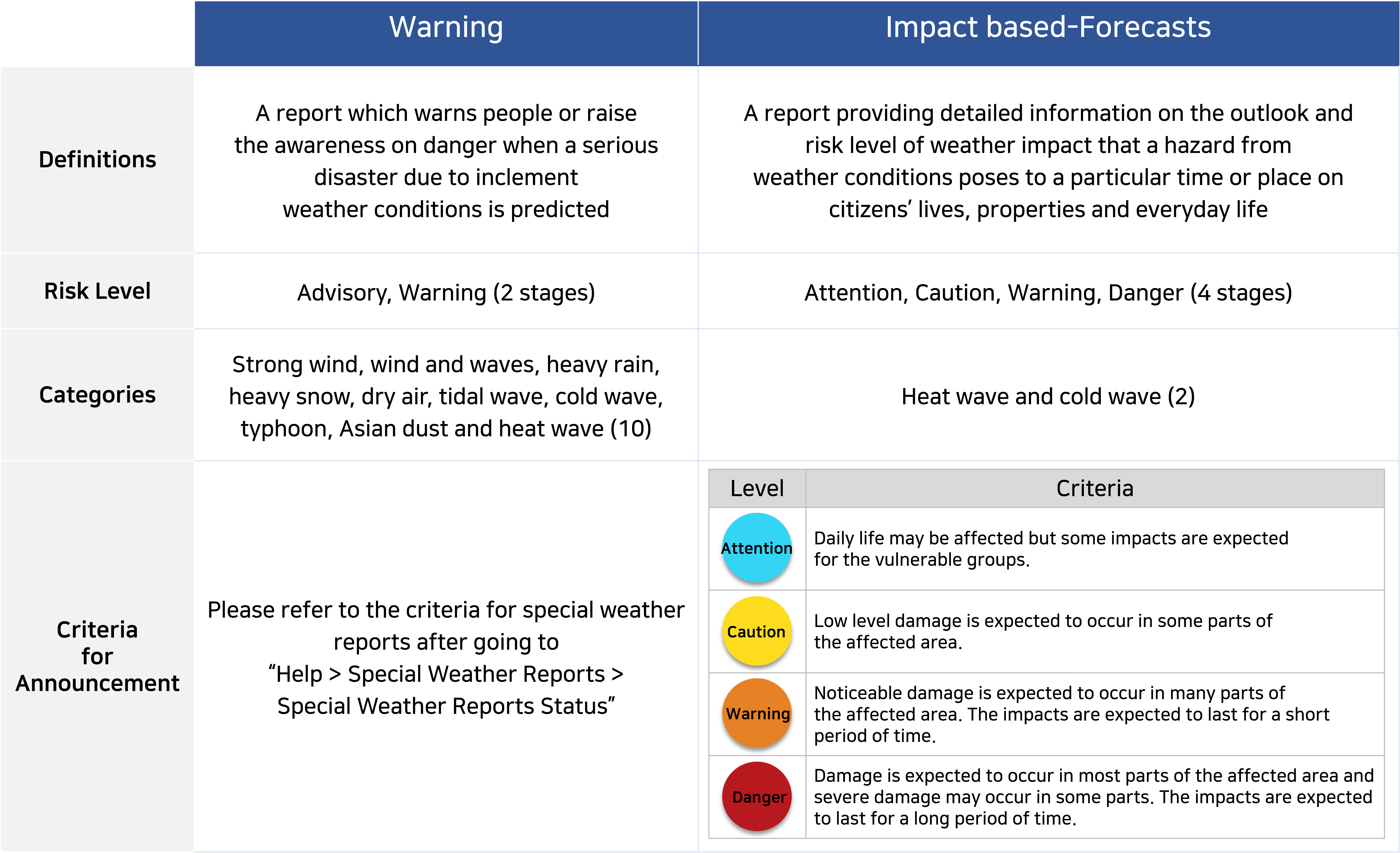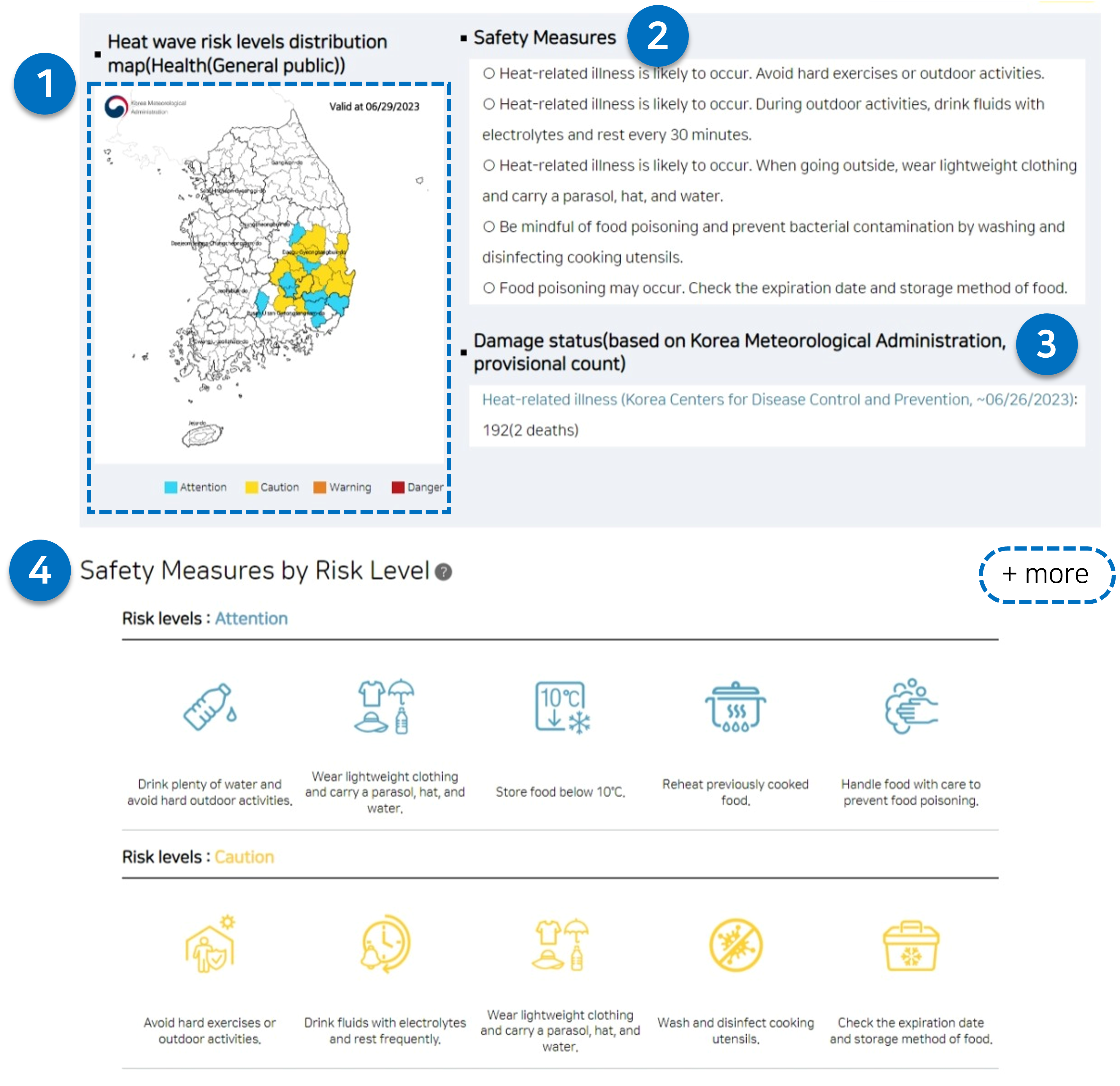What is an Impact-Based Forecast?
- An impact-based forecast is a more comprehensive approach to forecasting that utilizes scientific data to identify possible impacts that could vary by region and time, even under the same weather conditions.
- The Korea Meteorological Administration currently provides two types of impact-based forecasts: heat waves and cold waves.
- Impact-based forecasts classify the risk level of weather conditions into four stages: Attention, Caution, Warning, and Danger. Corresponding response guidelines are provided based on the risk level.
Why Do We Need Impact-Based Forecasts?
- Severe weather conditions caused by climate change are rapidly increasing, resulting in escalated damage. Additionally, vulnerability to such disasters is being amplified due to complex industrial structures and societal transformations, including aging populations and densely populated areas.
Therefore, to effectively prevent and respond to these changes, we need detailed and specific information on weather impacts that goes beyond simple data on weather conditions.
What is the Difference Between Special Weather Reports and Impact-Based Forecasts?
- A special weather report is issued to warn about the potential occurrence of hazards caused by meteorological phenomena.
- On the other hand, impact-based forecasts go beyond mere hazard warnings by providing detailed information. They consider the regional level of vulnerability and exposure to hazards, offering socio-economic impacts specific to each region, as well as countermeasures to prevent potential damage.
- Special Weather Reports and Impact-Based Forecasts

Details of Impact-Based Forecasts
Example of Impact-Based Forecast

- (1) Risk Map
- The geographic distribution of anticipated impacts and risk levels in the health sector resulting from weather hazards on a map, indicated by district units corresponding to special weather reports
- (2) Impact Outlook
- Forecasts of anticipated weather phenomena and their impacts, including weather outlook, expected major impact regions, expected impact sectors, and response guidelines
- (3) Damage Situation
- Structured damage data collected by relevant authorities and unstructured damage data from media and press releases, which provide an overview of the potential damage status up to the current date
- (4) Response Guidelines by Risk Level
- Each region offers response guidelines categorized into four risk levels for each sector. By clicking the ‘+’ button on the right, a pop-up window will appear, displaying response measures for all sectors.
- Sectors for impact-based heat wave forecasts: Health, industry, livestock, agriculture, aquaculture, and others
- Sectors for impact-based cold wave forecasts: Health, industry, facilities, agriculture and livestock, aquaculture, and others
- Response guidelines have been developed in consultation and review with relevant authorities, such as the Ministry of the Interior and Safety, the Ministry of Agriculture, Food and Rural Affairs, the Ministry of Health and Welfare, the Ministry of Environment, the Ministry of Employment and Labor, the Ministry of Land, Infrastructure and Transport, the Ministry of Oceans and Fisheries, the Rural Development Administration, and the Korea Disease Control and Prevention Agency. In cooperation with these authorities, the Korea Meteorological Administration provide the guidelines.
Keywords
- Weather Impacts
- The effects caused on people’s life and property, or everyday life in a particular time or place by hazards caused by meteorological phenomena
- Exposure
- The subject and period that may be under the influence of a disaster where a disaster may occur, such as commuting time, floating population, and distribution of crops
- Vulnerability
- The susceptibility or level of disaster preparedness of the elements exposed to hazards, including factors such as the distribution of the vulnerable populations, the presence of disaster prevention facilities, and the aging of the facilities

